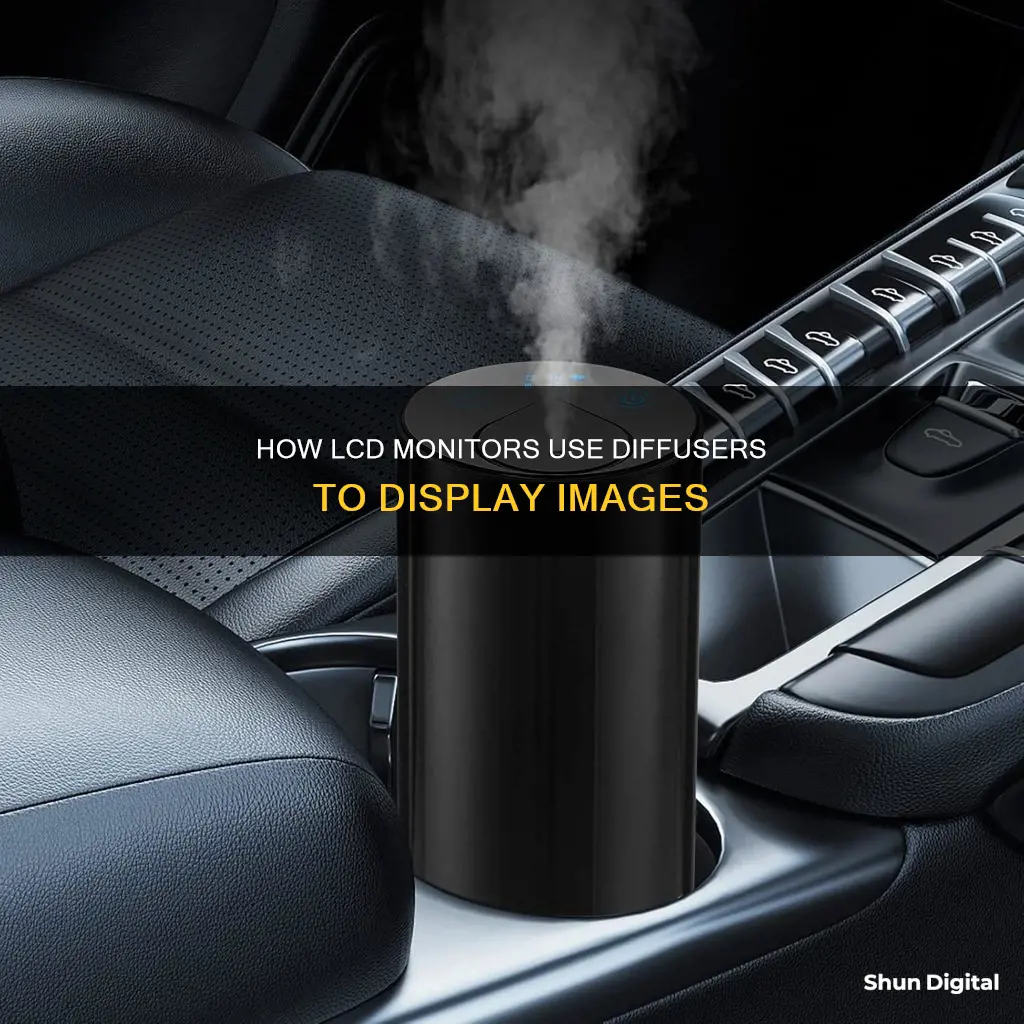
A diffuser is a component in a liquid crystal display (LCD) monitor that helps distribute light evenly across the screen. LCD monitors require an external light source to produce a visible image, as they don't emit light themselves. This light source, known as a backlight, is usually placed at the side or back of the display panel.
There are several types of backlights, such as light-emitting diodes (LEDs), cold cathode fluorescent lamps (CCFLs), and electroluminescent panels (ELPs). However, only ELPs provide a uniform ray of illumination across the entire display surface. All other backlights require the use of a diffuser to distribute light evenly.
The diffuser is a thin layer of plastic with uneven spaces that diffuses light as it passes through, preventing bright and dim spots on the display. It guides light to either the LCD display or a reflector, which redirects wasted light back to the LCD display, creating an even backlight.
| Characteristics | Values |
|---|---|
| Purpose | To illuminate the display panel and produce a visible image |
| Use | In LCDs that don't produce light by themselves |
| Types | Light-emitting diode (LED), Electroluminescent panel (ELP), Cold cathode fluorescent lamp (CCFL), Hot cathode fluorescent lamp (HCFL) and Incandescent |
| Function | Produce an even array of lighting by passing light through a layer of plastic with several uneven spaces |
| Benefits | Prevents bright and dim spots throughout the display, creating a functional and attractive display. |
What You'll Learn
- Diffusers are used in LCD backlights to produce an even array of lighting
- Diffusers are made of plastic and contain several uneven spaces
- Diffusers are placed between the backlight and the LCD display
- Diffusers can go bad over time, causing the LCD to produce uneven lighting
- Diffusers can be used to mask artifacts, such as seeing electronic components located behind the diffuser film

Diffusers are used in LCD backlights to produce an even array of lighting
There are several types of backlights, including light-emitting diode (LED), cold cathode fluorescent lamp (CCFL), and electroluminescent panel (ELP). ELPs are the only type of backlight that provides an even, uniform ray of illumination over the entire display surface. All other backlights require the use of a diffuser to produce an even array of lighting.
A diffuser is a small layer of plastic with uneven spaces that diffuses and distributes light evenly across an LCD display surface. As light travels through the diffuser, it is guided to either the LCD display or a reflector. The reflector takes wasted light and guides it back to the LCD display, creating an even, uniform backlight.
Without a diffuser, there would be bright spots and dim spots throughout the display, which is unattractive and dysfunctional. Diffusers solve this problem by passing light through a layer of plastic designed to diffuse it, resulting in an even distribution of light across the display.
LCD TV Monitors: Key Components Explained
You may want to see also

Diffusers are made of plastic and contain several uneven spaces
Diffusers are used in LCD backlights to produce an even array of lighting. They are made of plastic and contain several uneven spaces. As light travels through the diffuser, it is guided to either the LCD display or a reflector. The reflector takes the wasted light and guides it back to the LCD display, creating an even, uniform backlight.
LCDs do not produce light themselves, so they require a separate component to illuminate the display panel. The backlight is placed on the side or back of the panel to create an easy-to-see image. There are several types of backlights, including LED, ELP, CCFL, HCFL, and incandescent. However, only ELPs provide an even, uniform ray of illumination across the entire display surface. All other backlights require the use of a diffuser to create a consistent lighting array.
The diffuser is a layer of plastic that passes light through it, diffusing it as it travels through the several uneven spaces. This process ensures that the light is evenly distributed across the display, preventing bright or dim spots.
Understanding LCD and TFT Monitors: What's the Difference?
You may want to see also

Diffusers are placed between the backlight and the LCD display
There are several types of backlights, including light-emitting diodes (LEDs), electroluminescent panels (ELPs), cold cathode fluorescent lamps (CCFLs), hot cathode fluorescent lamps (HCFLs) and incandescent lights. However, ELPs are the only type of backlight that provides an even, uniform ray of illumination over the entire display surface. All other backlights require the use of a diffuser to produce an even array of lighting.
A diffuser is a thin layer of plastic with several uneven spaces that is designed to "diffuse" light. As light travels through the diffuser, it is guided to either the LCD display or a reflector. The reflector takes wasted light and guides it back to the LCD display, creating an even, uniform backlight. If the backlight didn't feature a diffuser, the wasted light would produce spots of uneven brightness, with some areas appearing brighter or dimmer than others.
Monitors for CAD: Size Considerations for Optimal Design Work
You may want to see also

Diffusers can go bad over time, causing the LCD to produce uneven lighting
Diffusers are used in LCD monitors to distribute light evenly across the screen. LCDs require a separate light source to illuminate the display panel and create an image. This is usually provided by a backlight, which is placed at the side or back of the panel.
There are several types of backlights, including LED, CCFL, HCFL, and incandescent. However, only ELP backlights provide an even, uniform ray of light across the display surface. All other types of backlights require a diffuser to ensure even lighting.
A diffuser is a layer of plastic with several uneven spaces that sits between the backlight and the LCD display. As light passes through the diffuser, it is distributed evenly across the screen. This prevents bright spots or dim spots from appearing on the display.
Over time, diffusers can go bad. When this happens, the LCD may produce uneven lighting or grayness on the display. This is because, without a functioning diffuser, the light from the backlight is not distributed evenly, resulting in spots of uneven brightness. Therefore, if your LCD is displaying uneven lighting, it may be due to a failing diffuser.
Asus Monitor Bluetooth: Is It Built-In or Not?
You may want to see also

Diffusers can be used to mask artifacts, such as seeing electronic components located behind the diffuser film
Diffusers are used in LCD backlights to produce an even array of lighting. LCDs do not produce light by themselves and require a separate component to illuminate the display panel. The backlight is placed on the side or back of the panel to create an easy-to-see image.
LCDs use a backlight to illuminate the display panel and subsequently produce a visible image. Unlike CRT displays, LCDs don't produce light themselves, so they need a separate component to illuminate the display panel. The backlight is usually the first layer from the back and can be made up of light-emitting diodes (LEDs), cold cathode fluorescent lamps (CCFLs), or other light sources.
Without a diffuser, there would be bright and dim spots throughout the display, which is unattractive and dysfunctional. A diffuser solves this problem by passing light through a layer of plastic designed to "diffuse" it. This layer of plastic, known as a diffuser, contains several uneven spaces. As light travels through the diffuser, it's guided to either the LCD display or a reflector. The reflector takes wasted light and guides it back to the LCD display, creating an even, uniform backlight.
Monitoring Bandwidth Usage: SolarWinds Simplified Guide
You may want to see also
Frequently asked questions
A diffuser is a component in an LCD monitor that helps to distribute light evenly across the screen. It is a layer of plastic with several uneven spaces that diffuses light as it passes through, creating a uniform backlight.
There are two main types of diffusers: the top diffuser and the bottom diffuser. The top diffuser has a low scattering power and is used to minimise glare and optical coupling. The bottom diffuser has a high scattering power and is used to hide features from the light guide and improve light uniformity.
A diffuser works by passing light through a layer of plastic with uneven spaces, which distributes the light evenly and guides it towards the LCD display. This helps to create a uniform backlight and improve the brightness of the screen.
The benefits of using a diffuser in an LCD monitor include improved uniformity in illumination, increased viewing angle, and reduced glare. Diffusers also help to hide electronic components and improve the overall aesthetics of the display.







